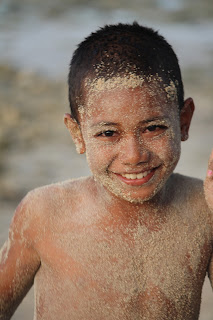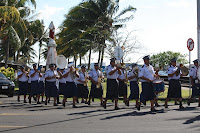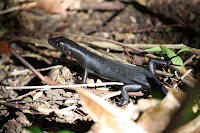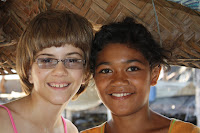Tonga has a land mass of 718 square miles, spread over 171 islands with a population of 105,000. Tongan and English are the official languages.
The Tongan Kingdom is comprised of 4 major groups. The Niuas in the north, the Vava'u and the Ha'apai groups in the middle and the Tongatapu group in the south. Since they are conveniently arranged north to south directly in our southern path to New Zealand, this is the order that we will visit them. We were originally going to try to visit Fiji as well, but will have to leave that for next year. We need to be in New Zealand by mid-November to avoid the cyclone season here.
The Niuas meaning "rich in coconuts" - are three extinct volcanoes. They are remote islands located roughly mid-way between Western Samoa and Vava'u - about 160 nautical miles from each. Given their location and their relative isolation, they were a particularly appealing destination for us.
Niuatoputapu is the only Niua that has anchorage for boats, and its anchorage is excellent. The island has been described as resembling a straw hat. It has a tall ridge (438 feet) in the center, and that ridge is surrounded by a broad area of lush vegetation and white sand beach. The anchorage is shadowed by an enormous, perfectly cone shaped volcano that really reminds us of the origins of many of the south Pacific islands.
We were hailed on the VHF radio by Sia who is the only one on the island with a radio. She welcomed us to Tonga and phoned the local officials to tell them that we had arrived. The officials drive to the concrete wharf and honk their horn. This is our signal to come and pick them up in our dingy since they do not have a boat. Three ladies came and the customs, health and immigration duties were completed quickly and our Tongan flag was raised.
 | |
| Sia serving up one of the 2 pigs |
 | |
| Sia's husband Niko |
 | |
| Dinner on the hoof |
We went ashore at the wharf which is in the easternmost village of Falehau, and I walked through the village of Vaipoa to get to the bank to get some Tongan money in the village of Hihifa. There are three villages on the island, and in less than an hour I had done a walk-through of each. Niuatoputapu is a relatively undeveloped island and they had been devastated by a tsunami in April of 2010. Many homes were destroyed and the Red Cross has provided several hundred kit homes.

The dress in Tonga is worth a note. As tourists from temperate climates, we have been fascinated with the conservative, traditional and, to our eyes, warm dress of the Tongans. Woman wear long shirts or tunics and blouses that cover the upper arm. Over this they usually wear either a kiekie, a decorative waistband with dangling woven strips of pandanus or a ta'ovala.
A ta'ovala is a woven mat of pandanus, often very large, which is wrapped around the waist and tied with a rope of woven pandanus or coconut fiber. The men always wear collared shirts, and often wear a wrap around skirt called a tupenu, also often accompanied with a ta'ovala. Several of the houses had the pandanus strips hung out drying in the sun.
We attended a pig roast that was prepared by Sia in an traditional Umu for all the boats in the harbor and later on Sunday we all had a pot luck lunch at her home after church. All the people were very friendly and the children loved to have their pictures taken. We cheered on several boys that were racing homemade coconut shell sail boats.
One day about 5 of us cruiser men brought hammers ashore and worked along side Sia's husband to build one of the Red Cross homes for the island. We got the roof up, windows and doors installed and very little remained to be done as the sun set. It was heart warming to see a 70 plus year old Tongan come up to our work site on a bicycle bringing us a lunch basket he had prepared for us. We found out that this house was to be his and he had been waiting for 5 months. He was very grateful and thanked us profusely. The erection of these homes has been painfully slow and he could not believe that we finished his home in one day. We were all sore for a few days but felt lucky to have been able to contribute a little to the people who had welcomed us so warmly.
Many of the families have horses and several families offered their horses so that we could have a ride one day. Emily was thrilled and we had a nice 2 hour ride. We would have enjoyed it more but we rode bareback and those bony backs were mighty lumpy!
We stayed in Niuatoputapu for about 10 days and made friends here that we will remember long after we sail over the horizon. Our next stop is the Vava'u island group where we will connect with many of our cruiser friends for a big 7-day PuddleJump party. Please come along.
Tom
Posted via SSB




































































